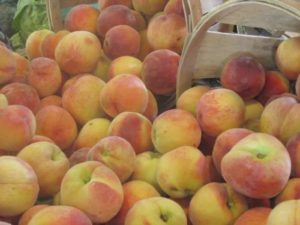 The peach continues to defy modern science. Actually, when I think about growing, harvesting, marketing, and eating peaches, they remain pretty much the same today as they were 20, 50, even 100 years ago. Peaches resist improvement!
The peach continues to defy modern science. Actually, when I think about growing, harvesting, marketing, and eating peaches, they remain pretty much the same today as they were 20, 50, even 100 years ago. Peaches resist improvement!
Peach trees grow the way they always have. Unlike apples, there have been no neat break-throughs such as the development of dwarf trees or disease-immune varieties. The peach tree still suffers from a short life span of only 10 to 20 years.
Peach trees are difficult to keep alive and healthy. Since they are not bred for cold hardiness, peach trees fall prey to spring frosts that kill the flower buds. Insects and diseases continue to vote peach tree the “host of choice.” These trees remain a challenge, even with Integrated Pest Management techniques (i.e., cultivating insects that eat harmful ones, monitoring the orchards for signs of disease and insect damage). Scourges like canker and tree borers continue to shorten their life span.
Fuzz perseveres as a prominent feature of the peach. I, personally, think peach fuzz is great, but I’ve heard people complain that it makes them itch, etc. We’ve even washed and brushed our peaches in an attempt to eliminate the fuzz. However, this treatment proved too damaging to the fruit, since we pick our peaches at the moment of tree-ripened perfection. Although waiting for this moment allows our peaches to be sweeter and juicier, they unfortunately become too perishable for such rough handling.
Another trait peaches stubbornly refuse to abandon is the ripening cycle — not all fruit on one tree is ready to be picked at the same time! Apple and pear trees, for instance, are all picked at once. Not peaches. In about a week, we pick peaches three or four times from the same tree. Each peach is picked on just the right day. Picking peaches requires special skill as some of you “pick-your-own” folks may have already discovered. Some peaches picked “a bit too green” will never really ripen to perfection. Those few extra days of “tree time” make an incredible difference in taste. In their own way, peaches are telling us to slow down, appreciate individuality, and not expect everyone to march to the same drummer.

The process of storing and handling peaches have also defied technology. Scientists seem to have a handle on apples — sugar content and firmness relative to how long an apple will stay hard and crisp in refrigeration or in controlled atmosphere storage. Peaches defy such storage methods and will tolerate refrigeration no longer than a week. While it is very old fashioned to lay your peaches out on your kitchen counter in one layer, it’s still the most effective way to know when they are ready to be eaten. Notice I didn’t say when you are ready to eat them. Peaches ripen on their own schedule, not yours!
To me, it’s OK that peaches resist modernization. While the process of growing and harvesting peaches may be inconvenient, all is forgiven when I’m eating one of Terhune Orchards warm-from-the-sun, dripping-with-juice peaches. I’m convinced that no technological break through could ever improve upon the flavor so generously bestowed by nature!
Read about freezing peaches.
Don’t forget to check out our peach recipes.
